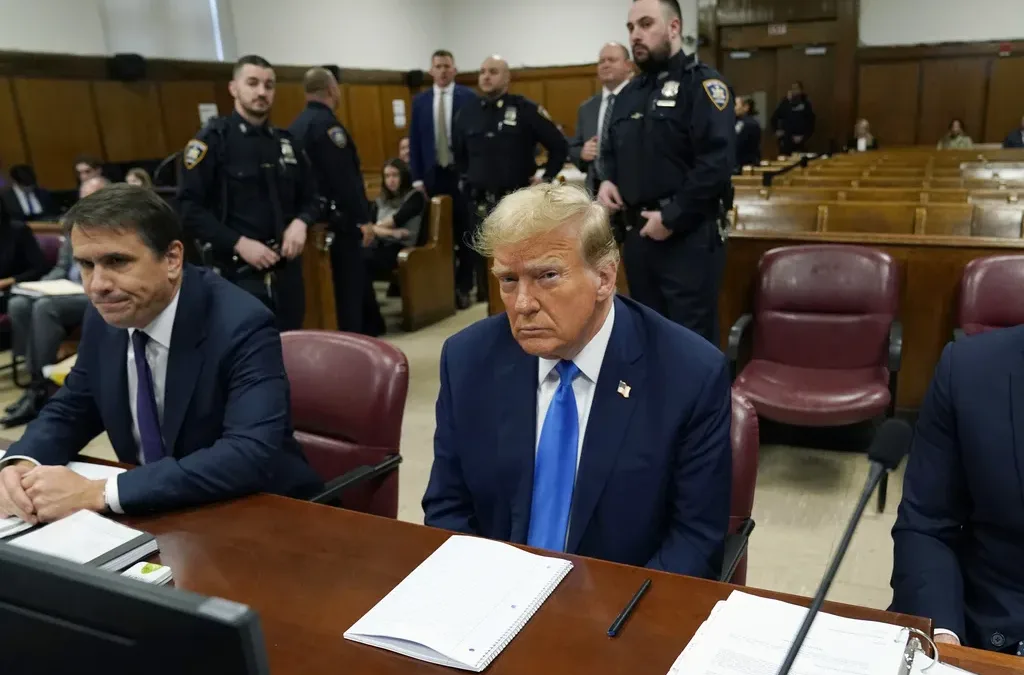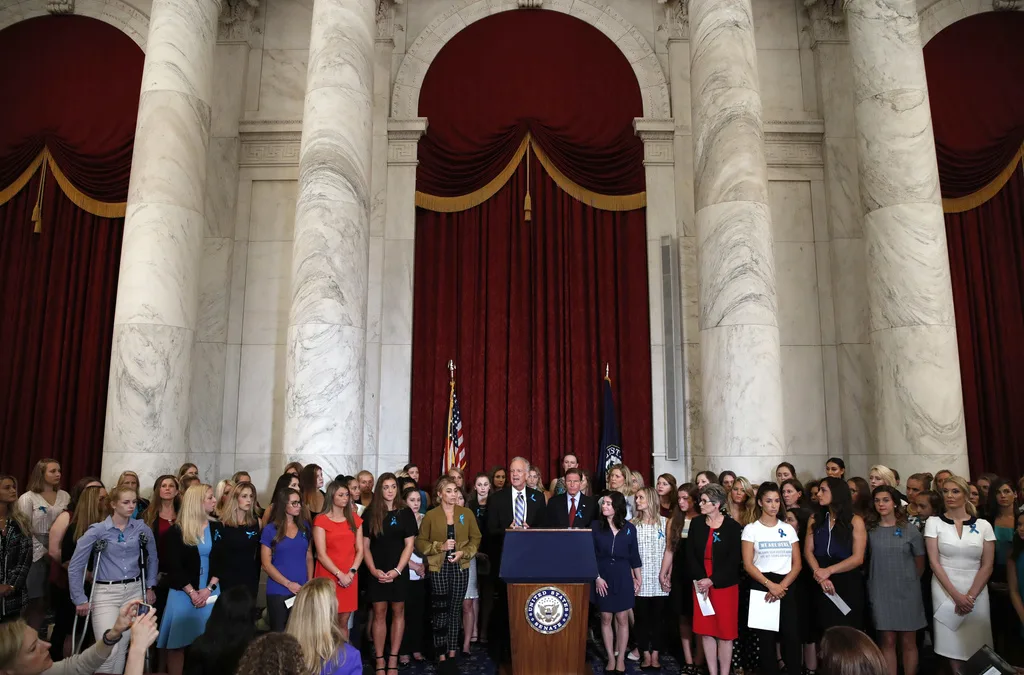
Michigan Gov. Gretchen Whitmer attends an event with President Joe Biden in the South Court Auditorium on the White House campus, Wednesday, March 9, 2022, in Washington. (AP Photo/Patrick Semansky)
A historic trial on domestic terrorism ended with a shocking verdict from the jury about a month ago. Here’s everything you need to know about this case (so far).
MICHIGAN–A month has passed since one of the country’s highest-profile domestic terrorism cases ended with no conviction by the jury. Four defendants were tried over an alleged plot to kidnap Gov. Gretchen Whitmer and overthrow the state government using violence.
On April 8, the jury found two men not guilty and deadlocked on two others, leading to a mistrial. All four men faced a kidnapping conspiracy charge that carried a potential penalty of life in prison.
While the trial itself only took less than a month, the FBI arrested the defendants a month before the 2020 election— almost two years ago— as the accused group tried to obtain an explosive to use in the kidnapping plot.
If you haven’t been paying attention to this historic domestic terrorism case, here’s a summary of key developments you may have missed.
How did it all get started?
On Oct. 8, 2020, the Justice Department announced that it had thwarted an elaborate plot by a group planning to kidnap Gov. Gretchen Whitmer from her vacation home in Northern Michigan and overthrow the state government by attacking the state Capitol. Three weeks later, the FBI found “explosive device components” and ghost guns following raids on related-properties.
Who was involved in the kidnapping conspiracy?
The FBI originally arrested 13 men suspected of orchestrating a domestic terror plot against Gov. Whitmer. Seven of the accused faced state terrorism charges, while the other six were to be tried in a federal court. A week later, a fourteenth suspect was arrested and charged in state court.
Of the six facing federal charges, two of them— Ty Garbin and Kaleb Franks— pleaded guilty before the trial began. Adam Fox, Barry Croft Jr., Daniel Harris, and Brandon Caserta were tried in a federal court in Grand Rapids in March where the latter two were found not guilty. The jury could not agree on the verdict for Fox and Croft, leading to a mistrial.
Five of the men were Michigan residents, while the sixth (Croft) was from Delaware.

When did the plan get started?
The plot was reportedly hatched in an official capacity on June 6, among a group of about a dozen individuals meeting in Dublin, Ohio. Fox and Croft were said to be present there. According to the FBI’s confidential source at the meeting, participants discussed peaceful and violent actions to establish a new, self-reliant society.
They also discussed political leaders they felt were in violation of the U.S. Constitution, how “tyrants” should be killed, and recruiting more members. Later that month, the group met at a Second Amendment rally in Lansing, where members were likely recruited.
According to an affidavit filed by the FBI, the conspirators further participated in a meeting to talk about “murdering tyrants” or “taking a sitting governor.” However, they soon realized “they needed to increase their numbers” to pull off their plans, impelling one individual to reach out to the Wolverine Watchmen, a Michigan militia group, requesting backup.
How were they caught?
Court documents state that the FBI had been investigating since early 2020, when the agency “became aware through social media that a group of individuals were discussing the violent overthrow of certain government and law-enforcement components.” An FBI informant attended the first meeting, held in Ohio, in June.
According to the Detroit Free Press, the men allegedly ordered “$4,000 worth of explosives” from an undercover FBI agent, who the indictment said was posing as a co-conspirator.
What was the group’s motivation?
Prosecutors said the plot was motivated by frustrations resulting from the Democratic governor’s strict COVID-19 restrictions and mitigation measures at the beginning of the pandemic.
“At one point, Michigan was ranked third in the nation for highest COVID-related cases and deaths. While Whitmer’s swift and early response was heralded by many leaders nationwide, it also made her a target of criticism from far-right groups.”
Additionally, Ty Garbin–one of the two men who pleaded guilty–told jurors they planned to execute the attack before the 2020 presidential election to prevent Joe Biden from winning. The Livingston County resident said a kidnapping would be the “ignition” for civil war, “and hopefully other states or other groups would follow suit.” Whitmer’s COVID-19 restrictions, he said, had brought the group to a breaking point.
“We wanted to cause as much [of] a disruption as possible to prevent Joe Biden from getting into office,” Garbin said during his testimony as a government witness.
How are militia groups involved?
Almost all the suspects in the plot were members of, or involved with, far-right militia groups.
Fox and Croft were affiliated with the “Three Percenter” anti-government movement, while the recently acquitted, Harris and Caserta, were members of the Wolverine Watchmen, a self-styled militia with similar views, according to prosecutors.
Wolverine Watchmen was founded by Munith residents Pete Musico and Joseph Morrison, both of whom are now facing state charges for their involvement in the plot to kidnap and potentially harm the state governor, and for recruiting members over Facebook. The group was reportedly an offshoot of the Michigan Militia, a paramilitary organization formed in response to perceived encroachments by the federal government on the rights of citizens.
When did the federal trial begin? What were the charges?
The trial for the four men who pleaded not guilty began on March 8.
Harris was charged on four counts: kidnapping conspiracy, possession of an unregistered destructive device, conspiracy to use a weapon of mass destruction, and possession of an unregistered short-barreled rifle. He was acquitted of all charges and free to go the afternoon of his acquittal, April 8.
Charged with one count of kidnapping conspiracy, Caserta was also acquitted after more than 18 months in jail following his arrest in an Ypsilanti warehouse.
Croft was charged with three counts, including possession of an unregistered destructive device — a firework wrapped with pennies that could serve as shrapnel – conspiracy to use a weapon of mass destruction, and a separate count of kidnapping conspiracy.
Fox was charged with kidnapping conspiracy as well as conspiracy to use a weapon of mass destruction.
What about the two who already pleaded guilty?
Garbin pleaded guilty in January 2021 and Franks in February. Both were government witnesses at trial.
In exchange for cooperation with the feds, Garbin received a lower sentence of six years in federal prison and did not face any additional charges. Garbin—who admitted to building a makeshift version of Whitmer’s second home on his property so the group could practice breaking in and kidnapping the governor— is currently serving the sentence while Franks awaits his sentencing.
During his testimony, Franks explained his role in the kidnapping plan, telling jurors he was going to be an operator — one of the gunmen on the frontline outside Whitmer’s home who would help grab the governor. Harris, Caserta and Garbin were also planning to serve in the same capacity, he said.
Both Garbin and Franks testified that no one convinced them or any of the others to join the plot to kidnap Whitmer.

What was the FBI’s role? Where does the claim of entrapment come in?
The FBI deployed undercover agents and informants in a sting that lasted until October 2020, when the defendants were arrested. Throughout the trial, the defense cited entrapment, alleging an FBI informant named Daniel “Big Dan” Chappel infiltrated the group and acted as a “double agent,” befriending and radicalizing the others to advance the plot.
As reported by the Detroit Free Press, Chappel is a former Army sergeant who joined the Wolverine Watchmen in the spring of 2020, but quit after hearing members talk about killing police, according to his testimony. He told jurors that he expressed his concerns to a police officer friend, and within a week the FBI had called to ask if he’d become an informant. He agreed.
Prosecutors had the burden of proving that the defendants weren’t entrapped by the FBI. Their trial strategy included showing that not only were the charged men predisposed to joining the kidnapping plot, but that they discussed such schemes before the FBI sting began.
What happened during the trial?
Here are some of the findings that came to light during the trial:
- Making explosives: Jurors heard a secretly recorded conversation that captured Croft talking to his 12-year-old daughter, who had interrupted his militia group meeting.
“Honey, I’m making explosives, can you get away from me please?” Croft can be heard telling his daughter, while his alleged co-conspirators laugh in the background.
- Anti-government group: Croft’s girlfriend, Chastity Knight, testified that he was “anti-government” and that he believed officials were out to “line their own pockets.” She told the jurors that she talked to Croft, who “doesn’t vote,” about the importance of voting “in order to get things to change.”
In fact, a review of state voting records found that five of the six men charged have not cast a ballot since 2012. Croft and Fox are not registered to vote in their home states of Michigan and Delaware, respectively.
- Scouting Whitmer’s cottage: Prosecutors argued that the suspects’ nighttime surveillance of Whitmer’s cottage was among the most damning pieces of evidence against the group. Fox allegedly drew a map of the area around Whitmer’s vacation house, which was shown to the jury along with the videos captured by an informant during the surveillance.
“Casing the governor’s house was overt,” Assistant U.S. Attorney Nils Kessler told jurors. “They didn’t have to agree when or how or why — they just had to agree that they were going to do it.”
- Social media posts: Jurors heard and saw provocative social media posts by all the defendants, who vented on Facebook, in texts, and in encrypted group chats.
“Which governor is going to end up being dragged off and hung for treason first?” Croft wrote in one Facebook post, which was shown to the jury. The prosecution emphasized that Croft was serious about harming people.
Facebook posts written by Caserta and entered into evidence were dark, Politico reports. He called the governor a “psychopath” and said the purpose of the Second Amendment is the “ability to kill agents of the government when they become tyrannical.”
- Blow up vaccine plants: Caserta was captured on secret recordings saying he wanted to blow up COVID-19 vaccine plants and kill contact tracers, lawyers, and doctors who pushed vaccination, according to the Free Press.
“Doctors who advocated mandated vaccines — bullet to the face,” Caserta is heard saying in recordings captured by an informant. “Any lawyer that supports a vaccine mandate, decapitate them in their own home.”
What happens next?
As of now, Croft and Fox remain in jail due to the mistrial but can be tried again. U.S. Attorney Andrew Birge said on April 8 that Fox and Croft are “awaiting trial and we’ll get back to work on that.”
In March, a judge ruled that the three men facing state charges for their involvement in the plot were not entrapped by the FBI. The two founders of Wolverine Watchmen, Morrison and Musico, along with Paul Bellar will face a tentatively scheduled pretrial examination in August and trial in September. They are accused of aiding the six men who were federally charged, providing materials to support terrorist acts, attempting to commit a felony as an associate or member of gang, and gun charges.
Politics

VIDEO: How Michigan public schools survived the pandemic
https://www.tiktok.com/@gandernewsroom/video/7357799499571531050

What to know about Trump’s legal issues
Over the past year, former president Donald Trump has become the center of not one, not two, not three, but four criminal investigations, at both...

Michigan lawmakers look to break (another) state funding record for public schools
Democratic lawmakers are hashing out plans to bring state funding for Michigan’s public schools to another new, all-time high—and ensure teachers...
Local News

Lawyers for Nassar assault survivors have reached $100M deal with Justice Department, AP source says
The US Justice Department has agreed to pay approximately $100 million to settle claims with about 100 people who say they were sexually assaulted...

More Michigan teens could soon take driver’s ed in their own schools
Privatization of driver’s education means that only 38 Michigan high schools offer affordable in-school driving classes for students. New grants...





